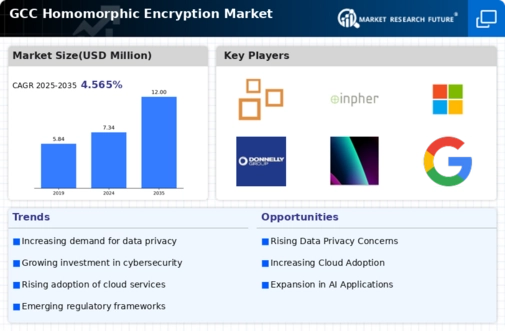The homomorphic encryption market is currently characterized by a dynamic competitive landscape, driven by the increasing demand for secure data processing and privacy-preserving technologies. Key players such as IBM (US), Microsoft (US), and Google (US) are at the forefront, leveraging their extensive research capabilities and technological expertise to innovate and expand their offerings. IBM (US) focuses on integrating homomorphic encryption into its cloud services, enhancing data security for enterprise clients. Meanwhile, Microsoft (US) emphasizes partnerships with academic institutions to advance research in this field, thereby positioning itself as a thought leader. Google (US) is actively investing in developing user-friendly applications of homomorphic encryption, which could potentially broaden its market reach and appeal to a wider audience. Collectively, these strategies indicate a trend towards collaboration and innovation, shaping a competitive environment that prioritizes technological advancement and customer-centric solutions.
In terms of business tactics, companies are increasingly localizing their operations to better serve regional markets, optimizing supply chains to enhance efficiency. The competitive structure of the market appears moderately fragmented, with several players vying for market share. However, the influence of major companies is substantial, as they set industry standards and drive technological advancements. This competitive interplay fosters an environment where smaller firms can innovate, yet they often find themselves at a disadvantage against the resources and capabilities of larger entities.
In October 2025, IBM (US) announced a strategic partnership with a leading financial institution to implement homomorphic encryption in their data processing systems. This collaboration is significant as it not only showcases IBM's commitment to enhancing data security in the financial sector but also highlights the growing recognition of homomorphic encryption as a viable solution for sensitive data handling. Such partnerships are likely to accelerate the adoption of this technology across various industries.
In September 2025, Microsoft (US) launched a new initiative aimed at integrating homomorphic encryption into its Azure cloud platform. This move is pivotal, as it positions Microsoft to offer enhanced security features that cater to enterprises concerned about data privacy. By embedding this technology into its cloud services, Microsoft is likely to attract a broader client base, particularly those in regulated industries that require stringent data protection measures.
In August 2025, Google (US) unveiled a new suite of tools designed to simplify the implementation of homomorphic encryption for developers. This initiative is crucial as it lowers the barrier to entry for organizations looking to adopt this technology. By making it more accessible, Google may significantly influence the market dynamics, encouraging wider adoption and fostering innovation among smaller firms that can now leverage these tools to enhance their own offerings.
As of November 2025, the competitive trends in the homomorphic encryption market are increasingly defined by digitalization, sustainability, and the integration of artificial intelligence. Strategic alliances are becoming more prevalent, as companies recognize the value of collaboration in driving innovation and expanding market reach. Looking ahead, it appears that competitive differentiation will evolve, shifting from traditional price-based competition to a focus on innovation, technological advancements, and supply chain reliability. This transition suggests that companies that prioritize research and development, alongside strategic partnerships, will likely emerge as leaders in this rapidly evolving market.

















Leave a Comment